Abstract
Escherichia coli isolated from cases of bacteremia and from a variety of urinary tract infections were characterized according to serotype (O:H antigenicity), K type (possession of K1, K2, K3, K12, or K13), hemagglutination (HA) type, and production of beta-hemolysin. Results obtained with the bacteremia and urinary tract infection isolates were similar except for more hemolytic isolated from urine than from blood (42 versus 29%) and more K1+ isolates from blood than from urine (50 versus 29%). A close correlation was found between Ha type VI (production of fimbriae which mediate mannose-resistant HA of human and African green monkey erythrocytes) and the production of hemolysin or K1 capsular antigen or both. Most (95 of 98, or 95%) of the HA type VI+ blood isolates and most (146 of 164, or 89%) of the HA type VI+ urine isolates produced hemolysin or K1 or both, in contrast to 22 and 26%, respectively, of those belonging to HA types other than HA type VI. Also, 76% of all hemolytic and 70% of all K1+ isolates belonged to HA type VI. Remarkably few of the HA type VI+ isolates (13%) and even fewer of the HA type VI- isolates (3%) produced both K1 and hemolysin; these belonged mainly to serotypes O16:H6, O18:H7 and O2:H4. Other major serogroups were usually K1+/hemolysin- (O1, O7) or K1-/hemolysin+ (O2, O4, O6). At least 74% (262 of 351) and possibly as many as 83% (293 of 351) of those isolates which produced mannose-resistant HA of human erythrocytes were classified as HA type VI+; 31 isolates produced mannose-resistant HA with all erythrocytes tested. Taking serogroup and serotype into consideration, we conclude that the E. coli fimbrial hemagglutinin(s) responsible for the HA type VI phenotype will prove to be the same as the virulence-associated mannose-resistant adhesins of uropathogenic E. coli which other investigators have characterized as unique fimbrial antigens detectable by mannose-resistant HA of human erythrocytes.
Full text
PDF

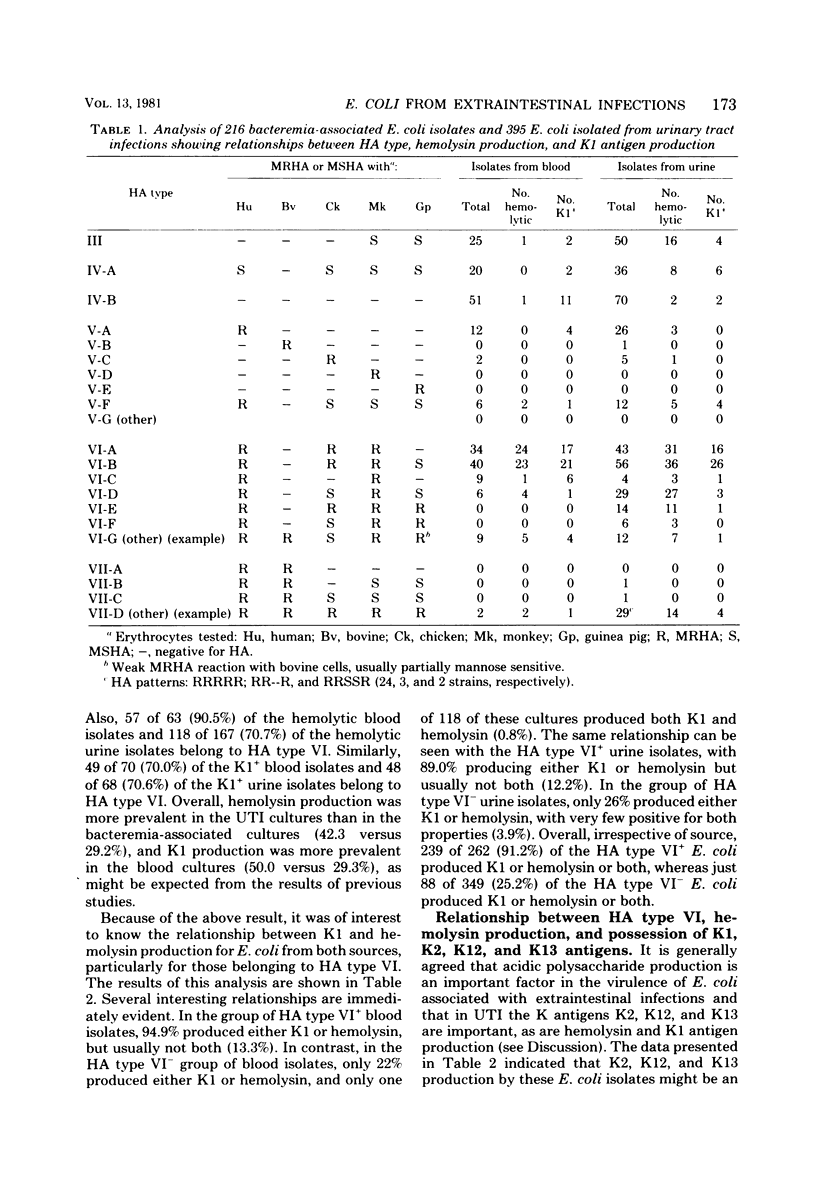
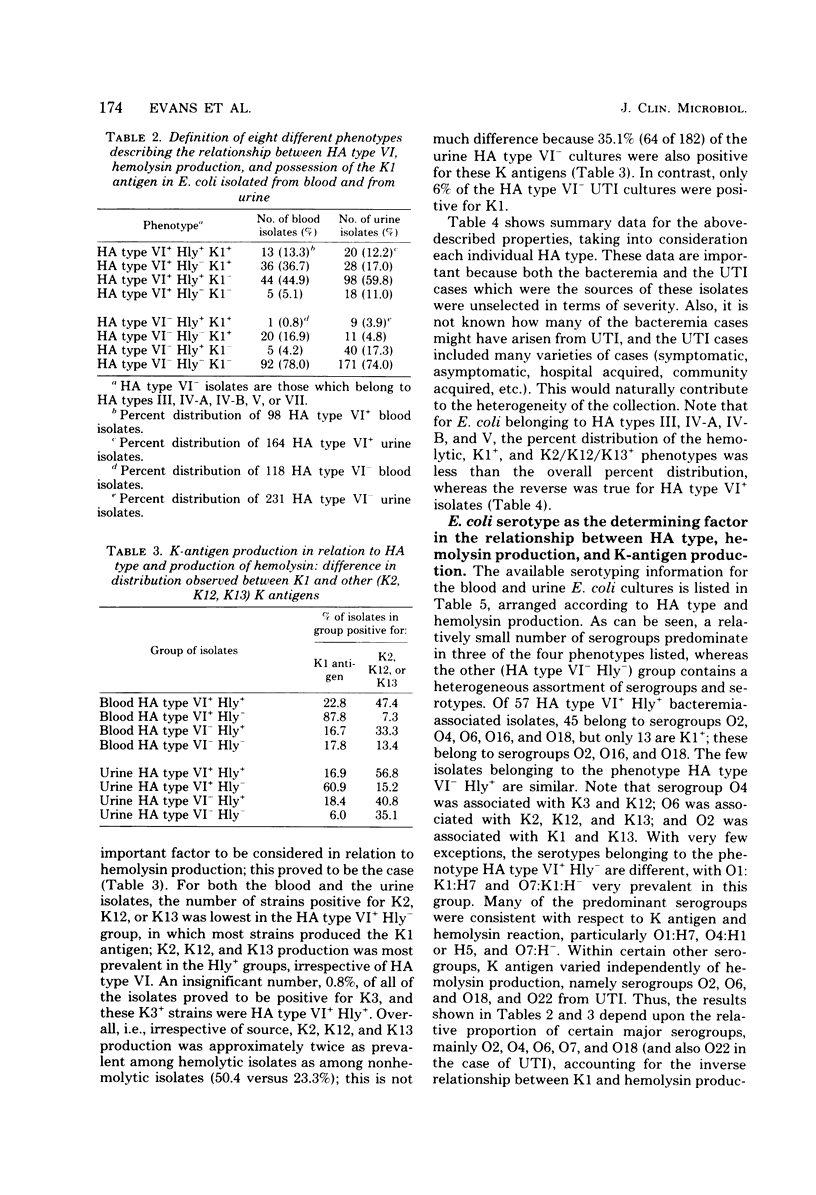
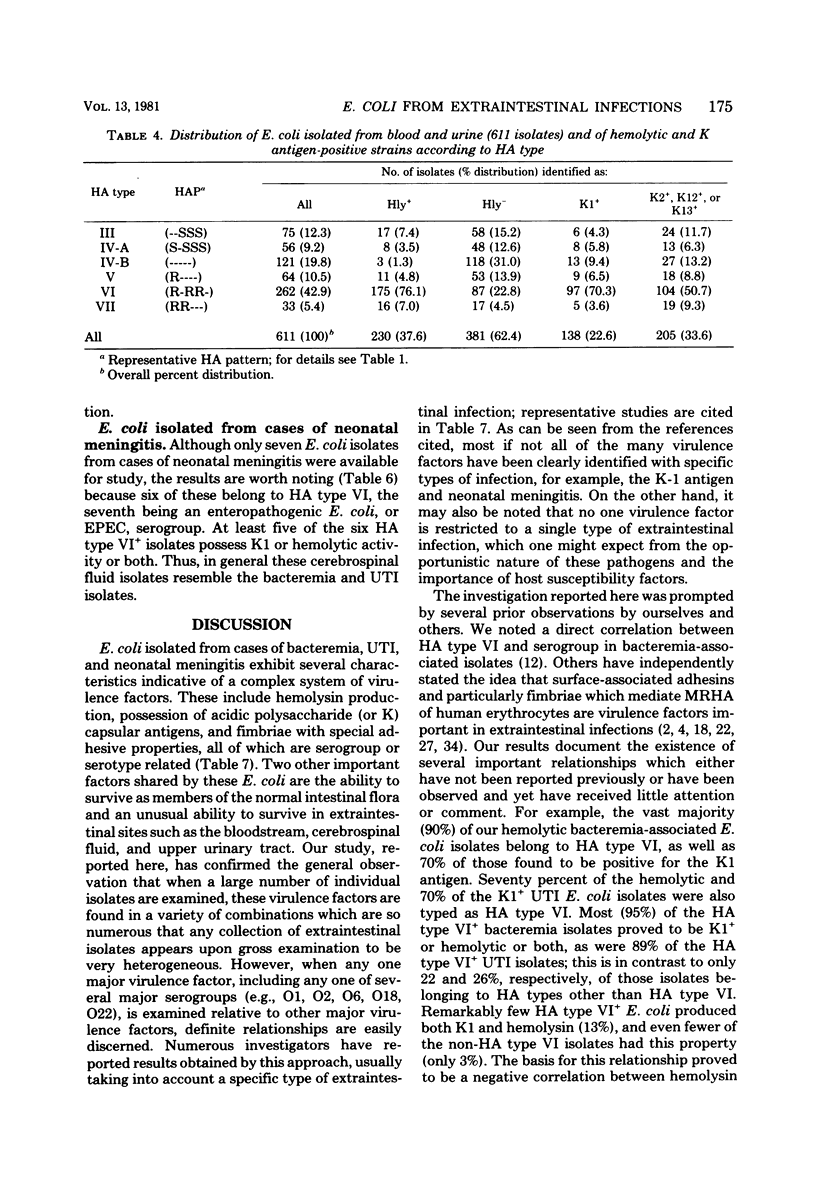
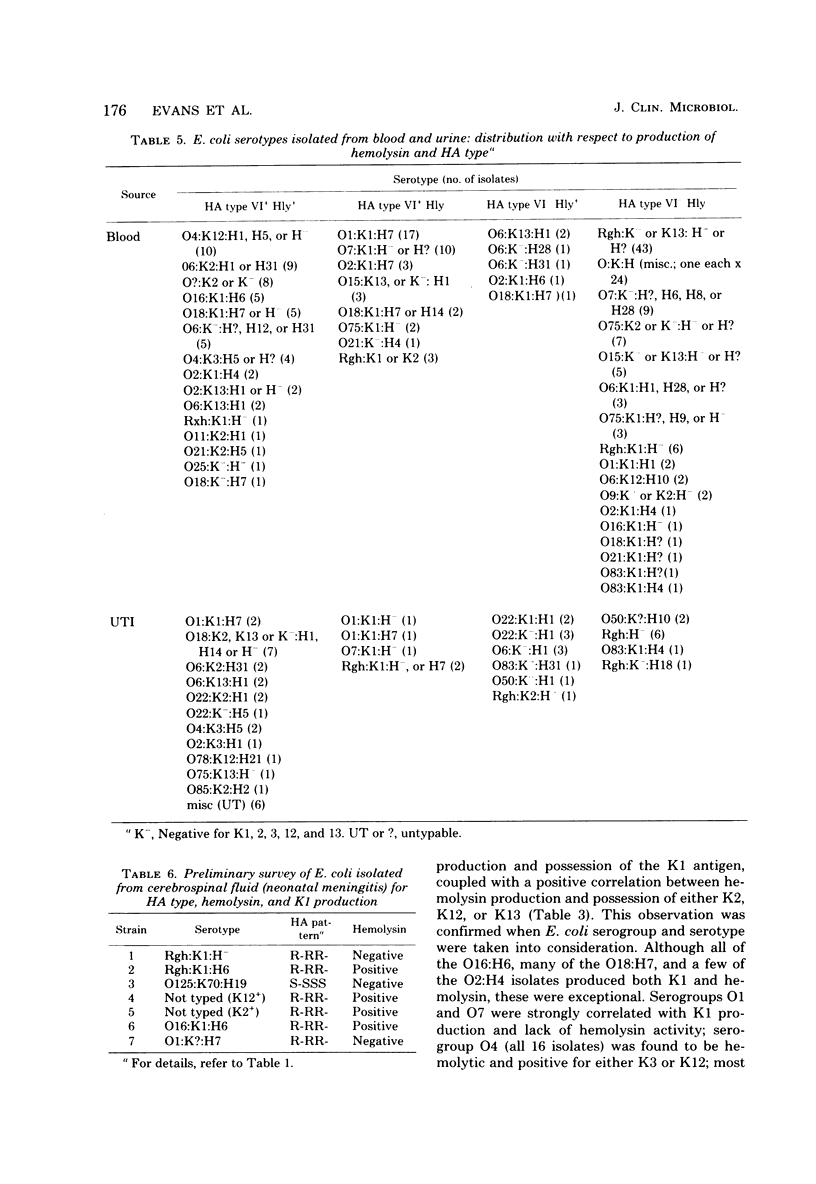

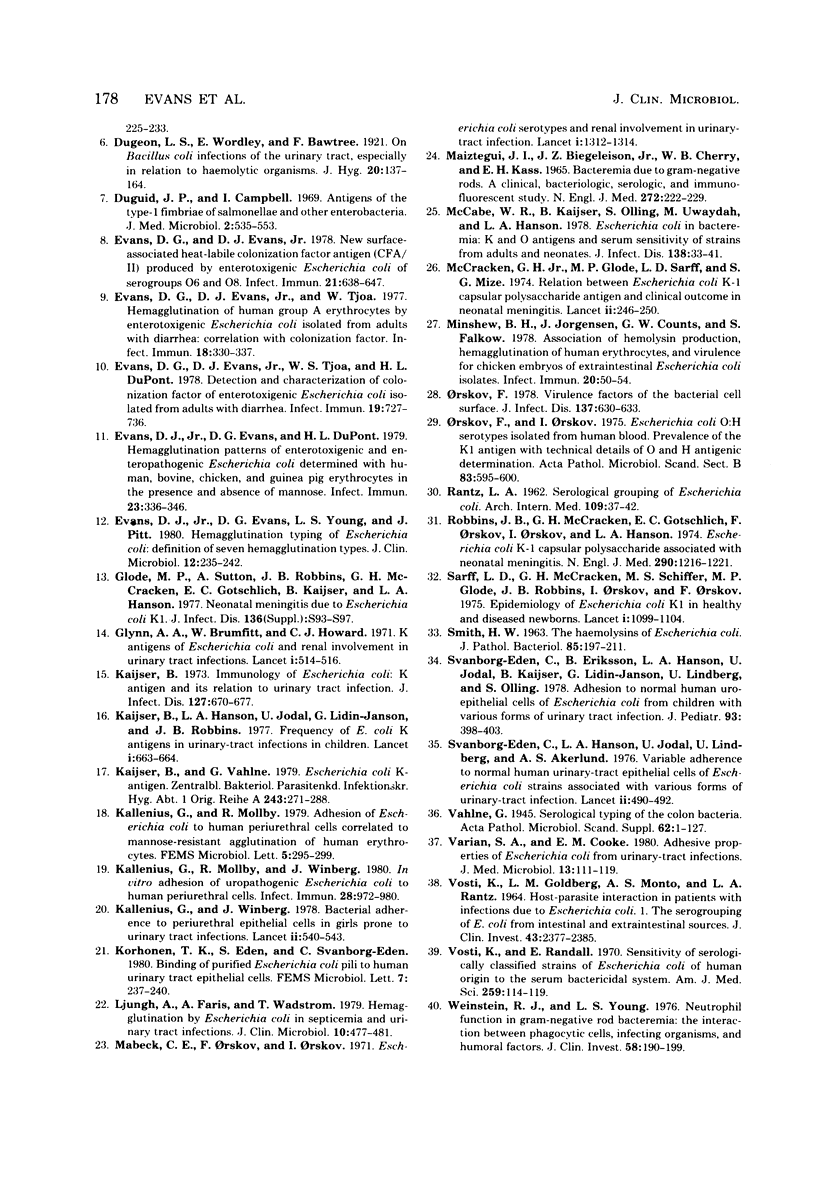
Selected References
These references are in PubMed. This may not be the complete list of references from this article.
- Brooks H. J., O'Grady F., McSherry M. A., Cattell W. R. Uropathogenic properties of Escherichia coli in recurrent urinary-tract infection. J Med Microbiol. 1980 Feb;13(1):57–68. doi: 10.1099/00222615-13-1-57. [DOI] [PubMed] [Google Scholar]
- Chabanon G., Hartley C. L., Richmond M. H. Adhesion to a human cell line by Escherichia coli strains isolated during urinary tract infections. J Clin Microbiol. 1979 Oct;10(4):563–566. doi: 10.1128/jcm.10.4.563-566.1979. [DOI] [PMC free article] [PubMed] [Google Scholar]
- Cooke E. M., Ewins S. P. Properties of strains of Escherichia coli isolated from a variety of sources. J Med Microbiol. 1975 Feb;8(1):107–111. doi: 10.1099/00222615-8-1-107. [DOI] [PubMed] [Google Scholar]
- Duguid J. P., Campbell I. Antigens of the type-1 fimbriae of salmonellae and other enterobacteria. J Med Microbiol. 1969 Nov 4;2(4):535–553. doi: 10.1099/00222615-2-4-535. [DOI] [PubMed] [Google Scholar]
- Edén C. S., Eriksson B., Hanson L. A., Jodal U., Kaijser B., Janson G. L., Lindberg U., Olling S. Adhesion to normal human uroepithelial cells of Escherichia coli from children with various forms of urinary tract infection. J Pediatr. 1978 Sep;93(3):398–403. doi: 10.1016/s0022-3476(78)81145-7. [DOI] [PubMed] [Google Scholar]
- Edén C. S., Hanson L. A., Jodal U., Lindberg U., Akerlund A. S. Variable adherence to normal human urinary-tract epithelial cells of Escherichia coli strains associated with various forms of urinary-tract infection. Lancet. 1976 Sep 4;1(7984):490–492. [PubMed] [Google Scholar]
- Evans D. G., Evans D. J., Jr New surface-associated heat-labile colonization factor antigen (CFA/II) produced by enterotoxigenic Escherichia coli of serogroups O6 and O8. Infect Immun. 1978 Aug;21(2):638–647. doi: 10.1128/iai.21.2.638-647.1978. [DOI] [PMC free article] [PubMed] [Google Scholar]
- Evans D. G., Evans D. J., Jr, Tjoa W. S., DuPont H. L. Detection and characterization of colonization factor of enterotoxigenic Escherichia coli isolated from adults with diarrhea. Infect Immun. 1978 Feb;19(2):727–736. doi: 10.1128/iai.19.2.727-736.1978. [DOI] [PMC free article] [PubMed] [Google Scholar]
- Evans D. G., Evans D. J., Jr, Tjoa W. Hemagglutination of human group A erythrocytes by enterotoxigenic Escherichia coli isolated from adults with diarrhea: correlation with colonization factor. Infect Immun. 1977 Nov;18(2):330–337. doi: 10.1128/iai.18.2.330-337.1977. [DOI] [PMC free article] [PubMed] [Google Scholar]
- Evans D. J., Jr, Evans D. G., DuPont H. L. Hemagglutination patterns of enterotoxigenic and enteropathogenic Escherichia coli determined with human, bovine, chicken, and guinea pig erythrocytes in the presence and absence of mannose. Infect Immun. 1979 Feb;23(2):336–346. doi: 10.1128/iai.23.2.336-346.1979. [DOI] [PMC free article] [PubMed] [Google Scholar]
- Evans D. J., Jr, Evans D. G., Young L. S., Pitt J. Hemagglutination typing of Escherichia coli: definition of seven hemagglutination types. J Clin Microbiol. 1980 Aug;12(2):235–242. doi: 10.1128/jcm.12.2.235-242.1980. [DOI] [PMC free article] [PubMed] [Google Scholar]
- Glode M. P., Sutton A., Robbins J. B., McCracken G. H., Gotschlich E. C., Kaijser B., Hanson L. A. Neonatal meningitis due of Escherichia coli K1. J Infect Dis. 1977 Aug;136 (Suppl):S93–S97. doi: 10.1093/infdis/136.supplement.s93. [DOI] [PubMed] [Google Scholar]
- Glynn A. A., Brumfitt W., Howard C. J. K antigens of Escherichia coli and renal involvement in urinary-tract infections. Lancet. 1971 Mar 13;1(7698):514–516. [PubMed] [Google Scholar]
- Kaijser B., Hanson L. A., Jodal U., Lidin-Janson G., Robbins J. B. Frequency of E. coli K antigens in urinary-tract infections in children. Lancet. 1977 Mar 26;1(8013):663–666. doi: 10.1016/s0140-6736(77)92111-0. [DOI] [PubMed] [Google Scholar]
- Kaijser B. Immunology of Escherichia coli: K antigen and its relation to urinary-tract infection. J Infect Dis. 1973 Jun;127(6):670–677. doi: 10.1093/infdis/127.6.670. [DOI] [PubMed] [Google Scholar]
- Kaijser B., Vahlne G. Escherichia coli K antigen. Zentralbl Bakteriol Orig A. 1979 Apr;243(2-3):271–288. [PubMed] [Google Scholar]
- Källenius G., Möllby R., Winberg J. In vitro adhesion of uropathogenic Escherichia coli to human periurethral cells. Infect Immun. 1980 Jun;28(3):972–980. doi: 10.1128/iai.28.3.972-980.1980. [DOI] [PMC free article] [PubMed] [Google Scholar]
- Källenius G., Winberg J. Bacterial adherence to periurethral epithelial cells in girls prone to urinary-tract infections. Lancet. 1978 Sep 9;2(8089):540–543. doi: 10.1016/s0140-6736(78)92880-5. [DOI] [PubMed] [Google Scholar]
- Ljungh A., Faris A., Wadström T. Hemagglutination by Escherichia coli in septicemia and urinary tract infections. J Clin Microbiol. 1979 Oct;10(4):477–481. doi: 10.1128/jcm.10.4.477-481.1979. [DOI] [PMC free article] [PubMed] [Google Scholar]
- MAIZTEGUI J. I., BIEGELEISEN J. Z., Jr, CHERRY W. B., KASS E. H. BACTEREMIA DUE TO GRAM-NEGATIVE RODS. A CLINICAL, BACTERIOLOGIC, SEROLOGIC AND IMMUNOFLUORESCENT STUDY. N Engl J Med. 1965 Feb 4;272:222–229. doi: 10.1056/NEJM196502042720502. [DOI] [PubMed] [Google Scholar]
- Mabeck C. E., Orskov F., Orskov I. Escherichia coli serotypes and renal involvement in urinary-tract infection. Lancet. 1971 Jun 26;1(7713):1312–1314. doi: 10.1016/s0140-6736(71)91884-8. [DOI] [PubMed] [Google Scholar]
- McCabe W. R., Kaijser B., Olling S., Uwaydah M., Hanson L. A. Escherichia coli in bacteremia: K and O antigens and serum sensitivity of strains from adults and neonates. J Infect Dis. 1978 Jul;138(1):33–41. doi: 10.1093/infdis/138.1.33. [DOI] [PubMed] [Google Scholar]
- McCracken G. H., Jr, Sarff L. D., Glode M. P., Mize S. G., Schiffer M. S., Robbins J. B., Gotschlich E. C., Orskov I., Orskov F. Relation between Escherichia coli K1 capsular polysaccharide antigen and clinical outcome in neonatal meningitis. Lancet. 1974 Aug 3;2(7875):246–250. doi: 10.1016/s0140-6736(74)91413-5. [DOI] [PubMed] [Google Scholar]
- Minshew B. H., Jorgensen J., Counts G. W., Falkow S. Association of hemolysin production, hemagglutination of human erythrocytes, and virulence for chicken embryos of extraintestinal Escherichia coli isolates. Infect Immun. 1978 Apr;20(1):50–54. doi: 10.1128/iai.20.1.50-54.1978. [DOI] [PMC free article] [PubMed] [Google Scholar]
- Orskov F., Orskov I. Escherichia coli O:H serotypes isolated from human blood. Prevalence of the K1 antigen with technical details of O and H antigenic determination. Acta Pathol Microbiol Scand Suppl. 1975 Dec;83(6):595–600. [PubMed] [Google Scholar]
- Orskov F. Virulence factors of the bacterial cell surface. J Infect Dis. 1978 May;137(5):630–633. doi: 10.1093/infdis/137.5.630. [DOI] [PubMed] [Google Scholar]
- RANTZ L. A. Serological grouping of Escherichia coli. Study in urinary tract infection. Arch Intern Med. 1962 Jan;109:37–42. doi: 10.1001/archinte.1962.03620130039006. [DOI] [PubMed] [Google Scholar]
- Robbins J. B., McCracken G. H., Jr, Gotschlich E. C., Orskov F., Orskov I., Hanson L. A. Escherichia coli K1 capsular polysaccharide associated with neonatal meningitis. N Engl J Med. 1974 May 30;290(22):1216–1220. doi: 10.1056/NEJM197405302902202. [DOI] [PubMed] [Google Scholar]
- SMITH H. W. The haemolysins of Escherichia coli. J Pathol Bacteriol. 1963 Jan;85:197–211. doi: 10.1002/path.1700850119. [DOI] [PubMed] [Google Scholar]
- Sarff L. D., McCracken G. H., Schiffer M. S., Glode M. P., Robbins J. B., Orskov I., Orskov F. Epidemiology of Escherichia coli K1 in healthy and diseased newborns. Lancet. 1975 May 17;1(7916):1099–1104. doi: 10.1016/s0140-6736(75)92496-4. [DOI] [PubMed] [Google Scholar]
- VOSTI K. L., GOLDBERG L. M., MONTO A. S., RANTZ L. A. HOST-PARASITE INTERACTION IN PATIENTS WITH INFECTIONS DUE TO ESCHERICHIA COLI. I. THE SEROGROUPING OF E. COLI FROM INTESTINAL AND EXTRAINTESTINAL SOURCES. J Clin Invest. 1964 Dec;43:2377–2385. doi: 10.1172/JCI105112. [DOI] [PMC free article] [PubMed] [Google Scholar]
- Varian S. A., Cooke E. M. Adhesive properties of Escherichia coli from urinary-tract infections. J Med Microbiol. 1980 Feb;13(1):111–119. doi: 10.1099/00222615-13-1-111. [DOI] [PubMed] [Google Scholar]
- Vosti K. L., Randall E. Sensitivity of serologically classified strains of escherichia coli of human origin to the serum bactericidal system. Am J Med Sci. 1970 Feb;259(2):114–119. doi: 10.1097/00000441-197002000-00005. [DOI] [PubMed] [Google Scholar]
- Weinstein R. J., Young L. S. Neutrophil function in gram-negative rod bacteremia. The interaction between phagocytic cells, infecting organisms, and humoral factors. J Clin Invest. 1976 Jul;58(1):190–199. doi: 10.1172/JCI108449. [DOI] [PMC free article] [PubMed] [Google Scholar]


